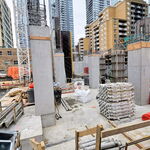Tuck
Active Member
Still can't believe that weasel is now the leader of the Ontario Liberals. Sigh.
Still can't believe that weasel is now the leader of the Ontario Liberals. Sigh.
Yea... shame.... well at least it'll be easier to ensure continuity of govtStill can't believe that weasel is now the leader of the Ontario Liberals. Sigh.
"Oceania was at war with Eastasia. Oceania had always been at war with Eastasia."If you guys care to go back a way you will see that I have NEVER said I think hydrogen was the best option and I have always said that battery should be the preferred one.
Battery is very much just catenary trains without the need for so many wires and infrastructure but the technology of the trains are exactly the same. The ONLY difference between the 2 is that one has bigger batteries. Battery trains are not new and they have been plying the rails for well over a 100 years. Battery trains have always be possible but, until recently with the lightening advancement of battery technology, they have never been practical.
Now they are practical and offer the benefits of a tried-and-true technology, zero emissions, efficiency, and quiet ride of standard catenary but with the flexibility of diesel. One of the primary disadvantages of catenary is not only the cost of the infrastructure itself but also it's inherent inflexibility. One of the benefits of diesel is that you can run the damn things anywhere you please with no new infrastructure required. This is part of the reason why many cities not only phased out their streetcars but also their trolleys.................they can't go all the places you want them to go. Battery gets rid of this problem as no new infrastructure is required to expand the system.
Certainly catenary wires have to be set up but only at specific points like terminus stations or where the trains maybe stationary for a length of time like Union. Outside of that all that is needed is recharging at each station itself and now that can be done contact-less just like many electric buses do worldwide. Battery is also not at the whim of Mother Nature, can store the electricity overnight hence buying the power when it's cheapest, doesn't have the upkeep and replacement costs associated with wires, and any extensions to service can be done automatically as opposed to having to do a new environmental review, going out to tender, and the cost and time to build the needed infrastructure. If Metrolinx decided it needs to extend RER to Hamilton, it would takes years to get it up and running while battery wouldn't require a damn thing and could be running tomorrow.
Battery trains simply offer the best of both worlds.
If you guys care to go back a way you will see that I have NEVER said I think hydrogen was the best option and I have always said that battery should be the preferred one
Also part of you never saying hydrogen is better than battery is because after it became clear that hydrogen was never being chosen, you switched from spamming this thread with only hydrail posts to spamming this thread with posts about why Metrolinx doesn't just choose battery or hydrogen and posts about hydrail and posts about battery trains.I know this whole project has gone out for request and the best bid regardless of the technology or even trains proposed and Metrolinx will base it's decision upon that but that is hypothetical. Metrolinx is at the beck and call of Queen's Park as both Wynne and Ford have clearly shown. Ford will make the final decision and he will do whatever he wants. One thing Ford has already proven in spades is his willingness to completely ignore recommendations and do what is most advantageous for him personally. This is why I think Ford will choose Hydrail.
Hydrail offers a plethora of political advantages over catenary or battery powered trains. First, it can built much faster due to far less infrastructure required and hence most of the system could be up and running BEFORE the next election. Second, It avoids the huge costs of upfront infrastructure which is of vital importance for a cost-cutting government. Third, it offers the opportunity and political brownie points of helping to kick start a hydrogen economy where Ontario technology is already at the forfront. Fourth, it allows suburbanites to get far superior service while also appeasing the crucial suburban Toronto voters by getting rid of the emissions and noise of diesel trains to say nothing of the catenary visual pollution. This will also help him "claim" he is serious about the environment and is making a decision that will result in zero emissions faster than Liberals.
This is all about politics kids and politically speaking, Hydrail offers benefits that catenary simply cannot compete with. Hydrail checks all the boxes and catenary absolutely none.
Pick your poison: Doug and his massively expensive subways to nowhere, or Del Duca and his delusional Hydrail and GO stations in the middle of nowhere.Still can't believe that weasel is now the leader of the Ontario Liberals. Sigh.
Also placing LRTs on every street and calling that good transit.Pick your poison: Doug and his massively expensive subways to nowhere, or Del Duca and his delusional Hydrail and GO stations in the middle of nowhere.
It's no wonder transit systems in the GTA are in a perpetual cycle of being screwed up one way or another.
meh, I think LRTs or BRTs on many of Toronto's major streets would be highly transformative and result in higher reliability, capacity and ridership. After all, Toronto is a city that relies very heavily on its surface transit for ridership - and is a major factor in why our subway system is actually very well used by North America standards - it's fed really well by surface transit. Thus, strengthening that surface transit is wonderful!Also placing LRTs on every street and calling that good transit.
Agreed. I just think the liberals equally had a problem in overindulging themselves on LRT similarly to Miller. Certain projects like Hurontario really should've been Canada Line style light metros and not at grade median LRTs.meh, I think LRTs or BRTs on many of Toronto's major streets would be highly transformative and result in higher reliability, capacity and ridership. After all, Toronto is a city that relies very heavily on its surface transit for ridership - and is a major factor in why our subway system is actually very well used by North America standards - it's fed really well by surface transit. Thus, strengthening that surface transit is wonderful!
But I will say that previous plans (Transit City?) seemed like it was selling LRT as a solution to *every transit problem in this city* - which it is not - subways have their place. For example, the Don Mills LRT and the SLRT - Don Mills is a natural subway extension of DRL/OL and the SLRT replaces an existing light metro with no real benefits over the original line being refurbished.
Happy I will be for the day a politician comes in and acknowledges that we need new subway, LRT, BRT and RER to improve our transit situation and to stop leaning on only one transit mode like it's the holy answer to this city's transportation problems *cough cough* Miller with his LRTs, Ford with his subways, maybe even Tory with his SmartStations
Anyways, I'm happy RER largely stays out of the noses of political debates, most of the time at least
Now that hydrogen is out of the picture, what do YOU guys think is the best answer? For myself it's obviously battery because I can't think of a single advantage catenary has over catenary battery. I am also on the record for single level EMU and think double level would be a ghastly mistake.
So, instead of just bitching at me, what do YOU propose for RER in terms of both technology and train types and why?
Well obviously catenary trains with some battery equipped trains units for low service areas like all day extensions to Niagara Falls. Any other proposals are gadgetbahn tier distractions from the primary goal of electrification of the GO lines.Now that hydrogen is out of the picture, what do YOU guys think is the best answer? For myself it's obviously battery because I can't think of a single advantage catenary has over catenary battery. I am also on the record for single level EMU and think double level would be a ghastly mistake.
So, instead of just bitching at me, what do YOU propose for RER in terms of both technology and train types and why?
A new Graphene Battery Market Research Report published on Valuates Reports in Electronics & Electrical Category. The report contains segmentation based on Type (Offset Printing, Intaglio Printing, Digital Printing, Other), Based on Application (Image, Painting, Pattern, Other). It also covers Global Opportunity Analysis and Industry Forecast to 2027.
The global Graphene Battery Market size was valued at USD 48.8 Million in 2019 and is projected to reach USD 398.6 Million by 2027, to register a CAGR of 31.2% during the forecast period.
Major factors driving the growth of graphene battery market size are, increasing demand in consumer electronics and automotive industries, continuous R&D and features such as rapid charging power, improved charge cycles, high-temperature performance, and extended charge holding time.
Graphene is an efficient conductor that is extremely lightweight and highly versatile with a wide surface area, making it an ideal material for high-capacity energy storage. Continuous R&D activities are underway to develop new and improved products, such as graphene-based supercapacitors and lithium-sulfur batteries. This continuous R&D is, in turn, expected to fuel the graphene battery market size.
The global demand for graphene batteries is driven by a rise in electric vehicles in the automotive sector and portable electronics, such as cell phones, laptops, tablets, and portable speakers. Thus, the growing adoption of graphene in the automotive sector is expected to increase the graphene battery market size.
Graphene is an excellent substrate to build high energy & density, lightweight, stretchable, fast charging, and long-lasting batteries for anchoring lithium battery anode and cathode materials. Calculations show that graphene has the ability to help realize supercapacitors with the energy density of batteries that can be recharged in seconds due to its incredible quantum capacitance and excellent electrical and mechanical properties. These features are, in turn, expected to increase the graphene battery market size.
The graphene battery's longer shelf life also serves as a catalyst for the graphene battery market size growth. However, high graphene battery manufacturing costs and prohibitive mass production of graphene batteries could hamper the market growth.
Europe is expected to hold the largest Graphene battery market share during the forecast period. This dominance of the European region is attributed to the presence of major graphene manufacturing companies in the region.
Asia-Pacific has been the second-largest revenue contributor in the graphene battery market and is expected to see considerable growth during the forecast period. This rapid growth of the Asia Pacific region is due to increased CO2 emission regulations and a growing understanding of non-conventional energy resources. For example, by accelerating electric cars' production, the Japanese government is targeting a 25 percent reduction in CO2 emissions by 2020 and 50 percent by 2050. The energy storage market requires graphene-based batteries with ultra-large capacity and rapid charge-and discharge capacity to achieve this.




